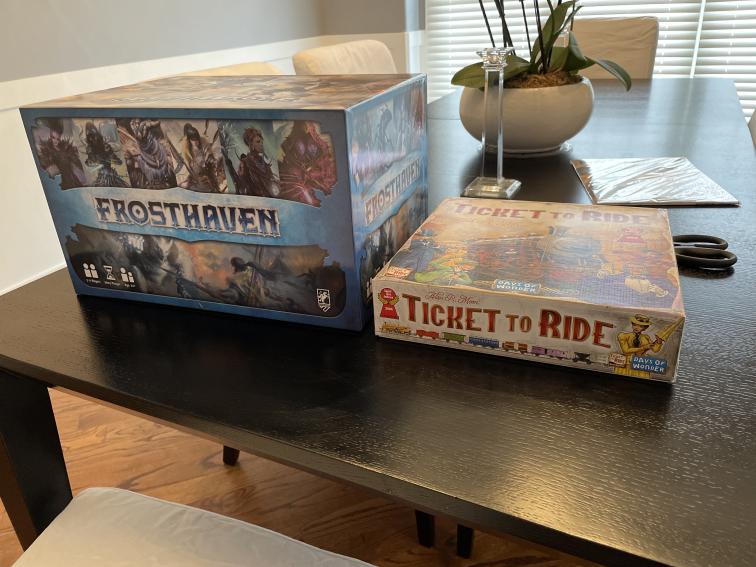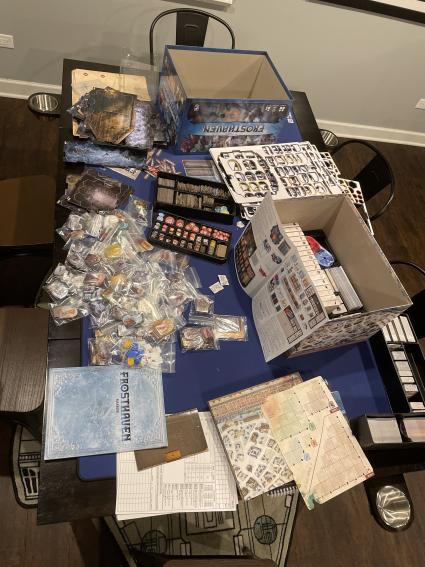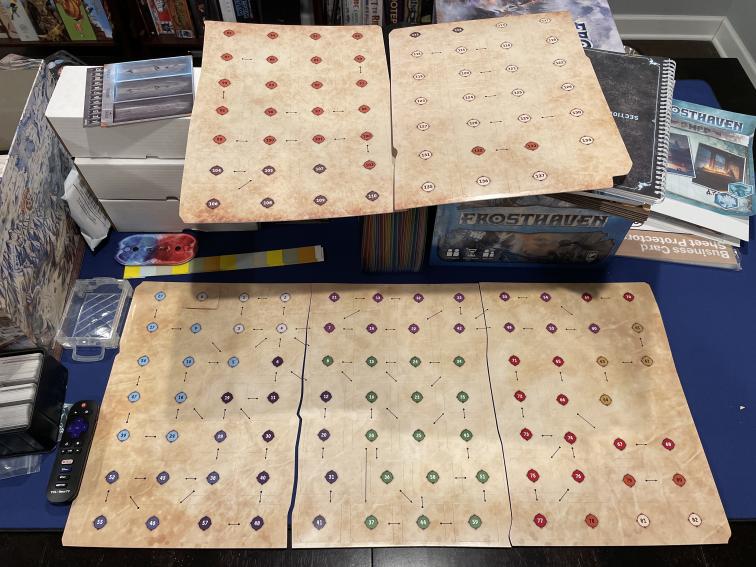If you’re at all plugged into the board gaming world you’ve probably heard a little bit about a game called Gloomhaven and it’s new sequel Frosthaven. These are now huge games, literally and figuratively, but it wasn’t always that way. While not Isaac Childres’ first game, Gloomhaven catapulted him into a house hold name and to the top echelon of the BGG rankings. Our KittySue is here to tell her story as we prep for a series of articles on Frosthaven.
I have to admit, I missed the initial furor over Gloomhaven. I was busy with family life, a tween with a mysterious illness, and a dog who needed a year of physical therapy. It was easy to miss the first time around; the first printing only had about 4900 backers when it became a hit upon delivery.
By the time the 2nd printing KS was released, I had heard a bit more. “Gigantic Co-op Dungeon Crawler” is about all I heard, and looking at the massive 300+ board game collection in moving boxes as we hauled across the country and searched for a new home complete with storage system and a good location for it all, I passed it over. The campaign was a little more difficult to ignore however, as the 2017 KS pulled about $4M from some 40,000 backers. But it was a legacy game, I pointed out. Why drop over $100 on something you can only play through once?

Then we started joining a gaming group at a FLGS and stories started coming past our ears as others waxed enthusiastic over what many people have nicknamed “D&D in a Box”. My partner started expressing regret in missing out on the fundraiser and made noises about getting a retail copy. Our friends were pointing out all the awards it had won, its prestigious standing on BGG, and how it was so darn fun. Every gaming site we followed was crowing about Gloomhaven; it was the talk of the convention circuit, too. I started feeling like we’d been living under a rock while the gaming world passed by at speed.
Then our own copy arrived.
I was seriously impressed. I thought that Descent and Mythic Battles were chunky games. Gloomhaven was a single box, in comparison, but oh, what a box! This nearly 20 pound monstrosity sat on the table for almost a month as we rearranged our shelves, punched out about 3 pounds of cardboard bits, and tried to put aside a weekend to dive in and grasp the learning curve. My family began the dungeon grind, failing often and restarting repeatedly as we figured out how to move as a group and pool our abilities without in-depth discussion of our turns like we did in other cooperative games. We didn’t get into it as often as we’d hoped, with a busy teenager, yearly fundraising, and a gaming group halfway across the county to mix with, we played Gloomhaven every couple of months, racking up about 30 hours of gameplay until the pandemic shut down most outside distractions. This isn’t even halfway through the game, so I felt a little better about playing my first legacy game.
As part of this article, we reached out to Isaac Childres, designer of Gloomhaven and head of Cephalophair Games to ask some questions about the success of Gloomhaven:
Give us your thoughts on the initial explosive demand for Gloomhaven. Felt like something blew up between the initial campaign and first shipment, that only grew.
I think things blew up with the first shipment, when Kickstarter backers and reviewers started getting their games. I kept people informed during the campaign, of course, and anticipation grew significantly as the updates painted a clearer and clearer picture of the game. But when it finally hit people’s doorsets and the sheer weight of it and amount of content inside became tangible to people, I think that’s when everyone else decided they needed a copy. Something that substantial just hadn’t been done before.
Gloomhaven has a sequel, an RPG, and merch now. What is that feeling like…to go from an initial KS campaign for a single game into a force and “franchise”?
Well, it has certainly been a learning and growing experience. We’re still a small team, but we’ve still leveled up so much from the time I was trying to do everything and run the company by myself. We’re really looking to this next crowdfunding campaign and the release of the RPG to really see how well things are working, but it feels pretty good right now.
Does it feel like people are experiencing both Haven games the way you want? It has drop in/out capabilities but does it feel like folks turn it into the beefiest same-group legacy game ever?
If people want to strictly have the same group every time, they’re free to do that, but it’s really just about flexibility, as being flexible allows you to accommodate more people. There’s not one way to play the game – we just want to do our best to make sure that there’s a way that works for as many people as possible. In my own group, if we can get three of the four members together for a game, that’s good enough for us.
Gloomhaven is a big game in a big box because the world is massive; it is a legacy game that changes as you make in-game decisions, picking paths, changing storylines, and building up and retiring different characters. This got occasionally problematic with my family as some of our goals contradicted the paths that other characters needed to take. There is so much to this game that we could only hope to circle back to other things as needed.

Then my kiddo graduated and went off to college, and we didn’t know how to continue with our speediest character on the other end of the state. It has sadly sat on the (lowest, for weight safety reasons) shelf in our game room, patiently waiting for the next winter or summer break when we’re all in the same house again. In the meantime, we saw the KS for Frosthaven drop. “Another Gloomhaven?” I asked. “Gloomhaven, on ice, bigger and better!” was the response. Surely not LITERALLY, PHYSICALLY bigger, right? Friends, they were not kidding.
Not only does Frosthaven have about 15 pounds on its predecessor, it’s a bigger box all around, and we will need to rearrange our shelving once again to add Big Sis here to the shelf lineup in a safe, earthquake-conscious manner. She has new character classes, new monsters to fight, new puzzles, items to craft, and a town to defend in the frozen north. You can import beloved characters from Gloomhaven or its expansions, and there’s even an app that has professionally produced audio for your campaign.
We are again punching out pounds of cardboard figures and sorting enemies into bags, planning a Friday night legacy game session with friends. I am looking forward to a more story-driven game, with a little more weight to elements outside of the everyday chambers of monster-slaying we’ve been doing. Not that I am bad at that, but my Gloomhaven character is a slower mover than I typically like to play and she’s not in a place where I can retire her just yet. I am interested in looking at the new Frosthaven classes and finding someone a little quicker on the initiative.

The Frosthaven map is roughly twice the size of Gloomhaven and in addition to Road and Town events outside of the dungeon slaying scenarios, Frosthaven has Seasonal Events in which you will suffer with the effects of the relentless winters if you didn’t prepare yourself and fortify your town enough while in Summer Events. The loot isn’t all about Gold anymore, either. You can collect material and herbs to craft weapons, repair buildings, and formulate potions in order to come back stronger, more clever, and more dangerous than before.
Also worth noting is that for this chapter of his universe, creator Isaac Childres hired a cultural consultant to dig through his characters and storylines and help him avoid common pitfalls of colonialism in this new story. James Mendez Hodes has combed through it all, helping to balance storylines and keep the game from portraying real-world cultures or racist ideas or terms that could damage people’s enjoyment of Frosthaven. As a result, the game’s narration is reportedly stronger than ever before, with more ethical content that is extra meaty and fulfilling to the player.
Every choice made in the game closes and opens doors in the group’s journey as they go along, and Frosthaven gives the players the choice to not become complicit in taking over other cultures in place on the map. I am glad to hear that these storylines will be a little less stereotypical and will work to avoid the colonizer culture bias we have seen through the decades of board games and RPGs alike.
I am definitely looking forward to side quests, puzzles, and building tools/weapons rather than buying everything outright. It will provide an additional layer to gameplay that I think the last game was pretty light on, and while I like a good hack-and-slash session on occasion, I believe these extra elements will make me want to put more time into the game overall. It seems like the world of Frosthaven will be a richer, more colorful place than we’ve seen before and I am here for it.
Stay tuned for more coverage of Frosthaven, including reviews and painting guides!


